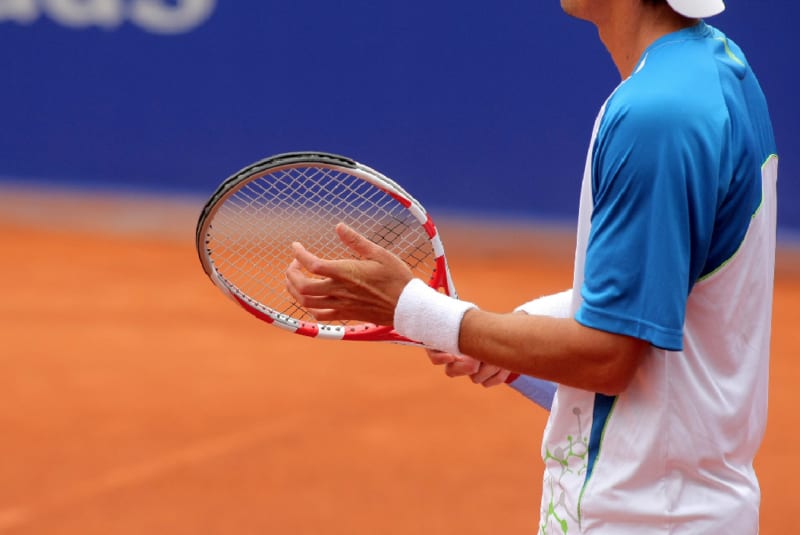Wimbledon may have ended but the tennis season is still in full flow!
Here are some top tennis tips from our professional musculoskeletal physiotherapist – Alex Manos. Covering injuries and advice for people considering taking up the sport or those currently playing.
Equipment
It’s vitally important that the racket you use is set up correctly for you. This means ensuring the grip size is appropriate, the weight and style of the racket suits your level and style of play. And perhaps most importantly, the string settings are correct. Even small adjustments can make a big difference to your game and potentially prevent injuries, mainly to the wrist and elbow as well as helping overcome existing injuries. It’s well worth going to a specialised tennis shop for advice on this.
Fitness for tennis
Tennis is mainly an anaerobic sport in that it is made up of short bursts of energy with rest but repeated often. If you are thinking of improving your fitness levels for tennis, training should replicate this. For example, you could do interval sessions on the bike (as opposed to pedalling continuously for 20 minutes or so) involving shorter intense bursts (15 secs up to a minute) with rest would be more beneficial. You could also do the same on treadmills or outdoor running. So more short sprint type interval training rather than long moderately paced runs. Circuits or what is commonly known as HIT (high intensity training) is a great way to work the entire body from a strength point of view. Also gaining cardiovascular benefits to give you a better engine during long matches! Focusing on lower limb stability exercises, with lunges being one of the best exercises is really important in being strong on court and allow for sharp, multidirectional changes of direction. A lot of force goes through the legs so having strong, balanced legs with good ability to safely change direction will help prevent injuries.

Common injuries
Unlike sports which are played on bigger pitches like football or rugby, with tennis been more contained to smaller areas, muscular injuries are less common as people don’t often reach maximal sprint pace for prolonged distances. So, tennis places more load on the joints and tendons than perhaps other sports due to the quick short change of direction and also the fact that it’s mainly played on hard surfaces.
Here are 4 common injuries
Lower back pain
It’s quite common for tennis players to suffer with painful lower backs. Serving in particular places high loads on the lower back and can compress the joints. The combined forces of quick extension and then rapid rotation and flexion can stress the joints. To try and prevent this it helps to have good mobility in your hips and lumbar spine together with a strong core. Focusing on core exercises which incorporate rotation, almost mimicking certain phases of the serve can really help reduce the risk of injury.
Shoulder injuries
Rotator cuff strains/pain. The rotator cuff is a group of muscles which surround the shoulder joint to provide stability and strength to the shoulder. It’s by nature not a very stable joint as it is so mobile. So when it is placed through high loads during ground strokes and more so in serving, it can lead to strains and/or inflammation of these structures. Working on the control and stability of these muscles by doing overall shoulder strength training but in particular lots of lighter rotational work will help prevent injuries.
Tennis elbow
Or, as it’s known clinically – Lateral Epicondylalgia is not exclusive to tennis but is prevalent, especially amongst amateur or club players. As stated above, equipment is key and so is technique on shots. The forearm muscles which move the wrist and elbow are small and not particularly strong. They are prone to being overstretched whilst under stress(particularly on backhand). Having good technique and also good strength in the wrist and shoulder can reduce the load on these delicate muscles.
Patellar tendon/Achilles tendon pain
As mentioned above, due to the start / stop nature of the sport, these joint and associate tendons take quite a beating! As with trying to prevent most tendon injuries around the body, keeping strong and conditioned in the bigger muscle groups will protect the joints and tendons. If you think of the joints as the area which will take the most force during movements, and the muscle system as the braking mechanism for this, the stronger and more efficient those brakes are to slow down the forces, the less load will be placed on those tendons and joints. If you have tendon pain already during tennis its important to seek professional advice. Patients often come to us with several months history of tendon pain as it can be painful but often can be ‘played through’. And it’s true, often with the correct advice and exercises you can continue to play but it needs to be properly assessed first.
If you think you may have an injury related to tennis or want some advice on any of the above or anything else please feel free to contact us or book in with one of our physiotherapists. Enjoy the tennis season and the strawberries and cream – but not too much cream!
Don’t let pain hold you back, book now!


